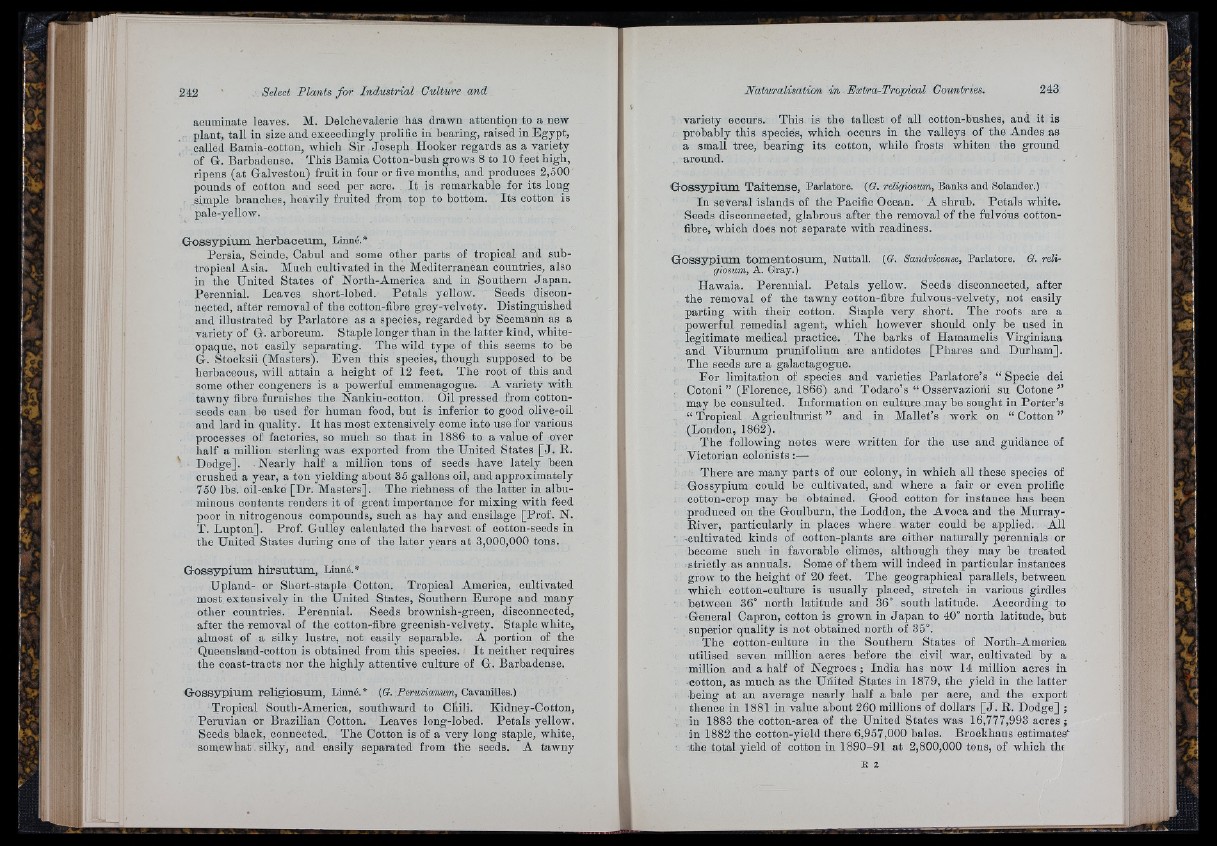
■
' ■ 1 i::i
'Y:
acuminate leaves. M. Delchevalerie has drawn attention to a new
plant, tall in size and exceedingly prolific in bearing, raised in Egypt,
called Bamia-cotton, which Sir Joseph Hooker regards as a variety
of G. Barbadense. This Bamia Cotton-bush grows 8 to 10 feet high,
ripens (at Galveston) frnit in four or five months, aud produces 2,500
pounds of cotton and seed per acre. I t is remarkable for its long
simple branches, heavily fruited from top to bottom. Its cotton is
pale-yellow.
G o s s y p ium h e r b a c e um , Linné.*
Persia, Scinde, Cabul aud some other parts of tropical and subtropical
Asia. Much cultivated in the Mediterranean countries, also
in the United States of North-America and in Sonthern Jap an .
Perennial. Leaves short-lobed. Petals yellow. Seeds disconnected,
after removal of the cotton-fibre grey-velvety. Distinguished
and illustrated by Parlatore as a species, regarded by Seemann as a
variety of G. arhoreum. Staple longer than in the latter kind, white-
opaque, not easily separating. The wild type of this seems to be
G. Stooksii (Masters). Even this species, though supposed to be
herbaceous, will attain a height of 12 feet. The root of this and
some other congeners is a powerful emmenagogue. A variety with
tawny fibre furnishes the Nankin-cotton. Oil pressed from cottonseeds
can be used for human food, but is inferior to good olive-oil
and lard in quality. I t has most extensively come into use for various
processes of factories, so much so th a t in 1886 to a value of over
h a lf a million sterling was exported from the United States [ J . R.
' Dodge]. Nearly half a million tons of seeds have lately been
crushed a year, a ton yielding about 35 gallons oil, and approximately
750 lbs. oil-cake [Dr. Masters]. The richness of the latter iu albuminous
contents renders it of great importance for mixing with feed
poor in nitrogenous compounds, such as hay and ensilage [Prof. N.
T. Lupton]. Prof. Gulley calculated the harvest of ootton-seeds in
the United States during one of the later years a t 3,000,000 tons.
G o s s y p ium h i r s u t u m , Linné.*
Upland- or Short-staple Cotton. Tropical America, cultivated
most extensively in the United States, Southern Europe and many
otlier countries. Perennial. Seeds brownish-green, disconnected,
after the removal of the cotton-fibre greenish-velvety. Staple white,
almost of a silky lustre, not easily separable. A portion of the
Queensland-cotton is obtained from this species. I t neither requires
the coast-traots nor the highly attentive culture of G. Barbadense.
G o s s y p ium r e lig io s um , Linné.* ((?. Perwvianum, Cavanilles.)
Tropical South-America, southward to Chili. Kiduey-Cotton,
Peruvian or Brazilian Cotton. Leaves long-lobed. Petals yellow.
Seeds black, connected. The Cotton is of a very long staple, white,
somewhat, silky, and easily separated from the seeds. A tawny
variety occurs. This is the tallest of all cotton-bushes, and it is
probably this species, which occurs in the valleys of the Andes as
a small tree, bearing its cotton, while frosts whiten the ground
around.
G o s s y p iu m T a ite n s e , Parlatore. (ff. religiosum, Banks and Solander.)
In several islands of the Pacific Ocean. A shrub. Petals white.
Seeds disconnected, glabrous after the removal of the fulvdtis cotton-
fibre, which does not separate with readiness.
G o s s y p iu m to m e n to s u m , Nuttall. ((?. Sandvicense, Parlatore. G. religiosum,
A. Gray.)
Hawaia. Perennial. Petals yellow. Seeds disconnected, after
the removal of the tawny cotton-fibre fulvous-velvety, not easily
parting with their cotton. Staple very short. The roots are a
powerful remedial agent, which however should only be used in
legitimate medical practice. The barks of Hamamelis Virginiana
and Viburnum prunifolium are antidotes [Phares and Durham].
The seeds are a galactagogue.
For limitation of species and varieties Parlatore’s “ Specie dei
. Cotoni ” (Florence, 1866) and Todaro’s “ Osservazioni su Cotone”
may be consulted. Information on culture may be sought in Porter’s
“ Tropical Agriculturist ” and iu Mallet’s work on “ Cotton ”
(London, 1862).
The following notes were written for the use and guidance of
Victorian colonists:—
There are many parts of our colony, in which all these species of
Gossypium could be cultivated, and where a fair or even prolific
cotton-crop may be obtained. Good cotton for instance has been
produced on the Goulburn, the Loddon, the Avoca and the Murray-
River, particularly in places where water could be applied. All
■ -cultivated kinds of cotton-plants are either naturally perennials or
become such in favorable climes, although they may be treated
strictly as annuals. Some of them will indeed in particular instances
grow to the height of 20 feet. The geographical parallels, between
which cotton-culture is usually placed, stretch in various girdles
between 36° north latitude and 36° south latitude. According to
General Capron, cotton is grown in Jap an to 40° north latitude, but
superior quality is not obtained north of 35°.
The cotton-culture in the Southern States of North-America
utilised seven million acres before the civil war, cultivated by a
million and a half of Negroes ; India has now 14 million acres in
cotton, as much as the United States in 1879, the yield in the latter
being a t an average nearly half a bale per acre, and the export
thence in 1881 in value about 260 millions of dollars [ J . B. Dodge] ;
iu 1883 the ootton-area of the United States was 16,777,993 acres ;
in 1882 the cottou-yield there 6,957,000 bales. Brockhaus estimates“
th e total yield of cotton in 1890-91 a t 2,800,000 tons, of which thf
i,' -
'i.fr